Key takeaways:
- Effective risk management requires identifying and prioritizing risks, setting stop-loss orders, and managing emotional reactions to market fluctuations.
- Diversification of investments and continuous education are essential strategies to mitigate risks in the volatile cryptocurrency market.
- Regularly assessing risk tolerance and leveraging tools that provide real-time insights can enhance investment safety and decision-making.
- Learning from past mistakes and emotional biases is crucial for developing a more resilient and informed approach to investing.
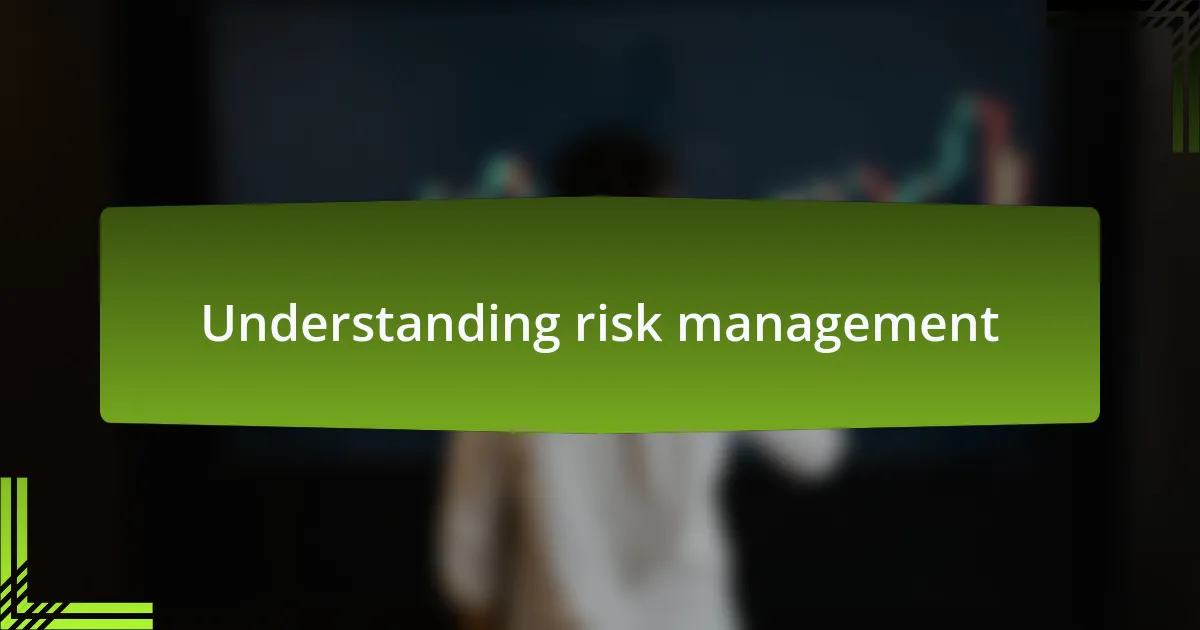
Understanding risk management
Risk management is an essential aspect of any investment strategy, especially in the volatile world of cryptocurrency. I remember when I first ventured into crypto; the wild price swings were both exhilarating and terrifying. It prompted me to ask, how do I protect my investments while still reaping potential rewards?
Effective risk management involves identifying, assessing, and prioritizing risks, followed by coordinated efforts to minimize, monitor, and control the impact of those risks. For instance, when I allocate funds to various digital assets, I always consider how much I’m willing to lose. This reflection is crucial because it helps me set stop-loss orders, which serve as a safety net during market downturns.
Moreover, it’s not just about the numbers; it’s also about psychology. I’ve found that understanding my own emotional responses to market fluctuations is just as vital. Have you ever let fear drive your decisions? I certainly have, and realizing this has led me to incorporate strategies that keep my emotions at bay, like setting clear entry and exit points before making a trade.
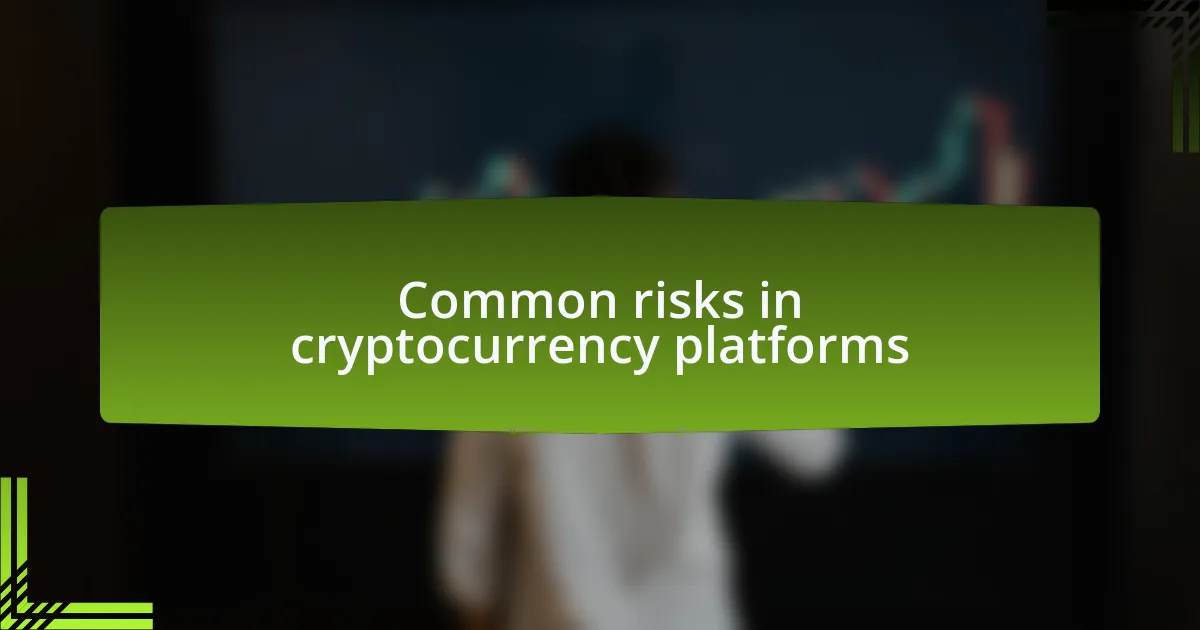
Common risks in cryptocurrency platforms
Navigating a cryptocurrency platform comes with unique risks that both newcomers and seasoned investors must consider. One major risk is market volatility; I recall a day when the market dropped by 30% in mere hours. It made me think, can I really afford to hold onto my investments during such dramatic swings? It’s a stark reminder that prices can fluctuate wildly, making it essential to stay informed and prepared for sudden changes.
Another significant risk is security breaches. I once signed up for a platform that was later hacked, leading to the loss of funds for many users, including myself. That experience raised an important question: how secure is your exchange? I’ve since learned the value of using two-factor authentication and storing my assets in cold wallets to protect against potential cyber threats.
Regulatory changes also pose risks that can impact your investments. I used to assume that the regulatory environment was stable, but one sudden announcement from a government can change everything overnight. It got me thinking about the need to stay updated on laws and how they can affect the usability and value of cryptocurrencies. These risks remind us that a proactive approach and continuous learning are key to thriving in the crypto space.
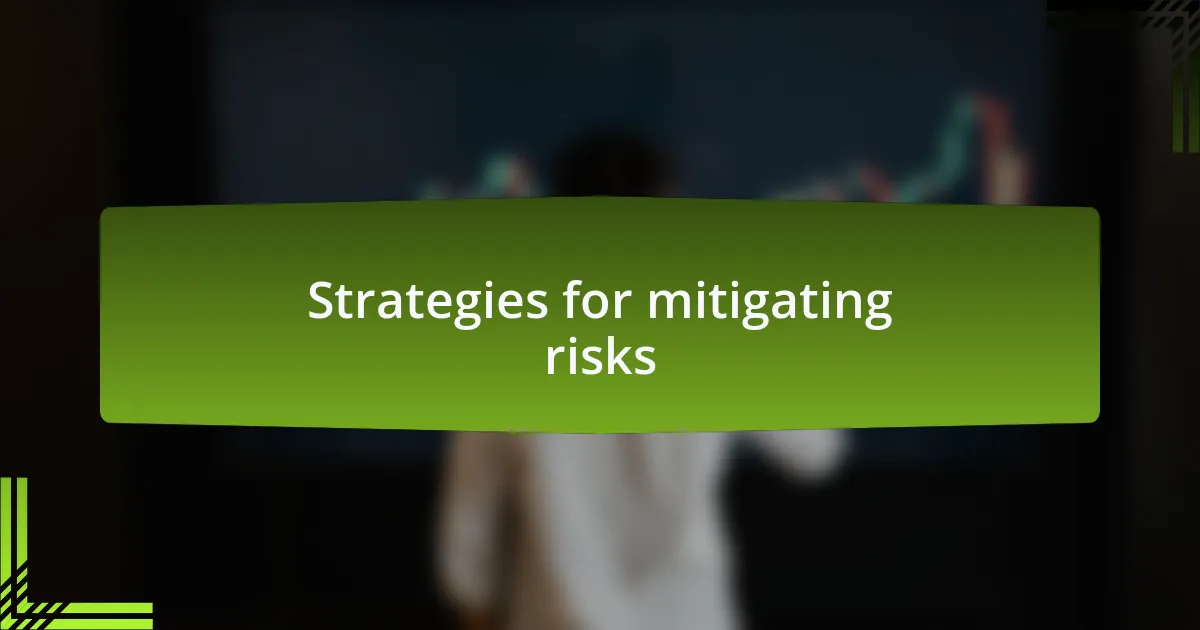
Strategies for mitigating risks
When it comes to mitigating risks in the cryptocurrency space, I’ve found that diversification is a powerful strategy. Instead of putting all my funds into one or two cryptocurrencies, I spread my investments across various assets. This approach not only helps reduce the impact of a single asset’s poor performance but also gives me the chance to benefit from the potential growth of multiple projects. I often ask myself, “What does my portfolio look like?” Regularly assessing my distribution helps me stay balanced and adaptable.
Another effective strategy is setting stop-loss orders. I remember a time when I thought I could ride out a market dip, only to watch my investments dwindle. Having stop-loss orders in place allows me to set predetermined sell points, which have saved me from deeper losses during turbulent times. Have you ever felt the sting of watching a small loss turn into a larger one? I certainly have, which is why I now prioritize these alarms to protect my capital.
Lastly, I can’t stress enough the importance of continuous education. There was a phase when I relied heavily on market hype, and it didn’t end well for me. Engaging with reputable sources, attending webinars, and participating in community discussions have enriched my understanding of the market dynamics. So, how do you keep yourself informed? I’ve learned that staying educated empowers me to make better decisions, reducing my risks significantly.
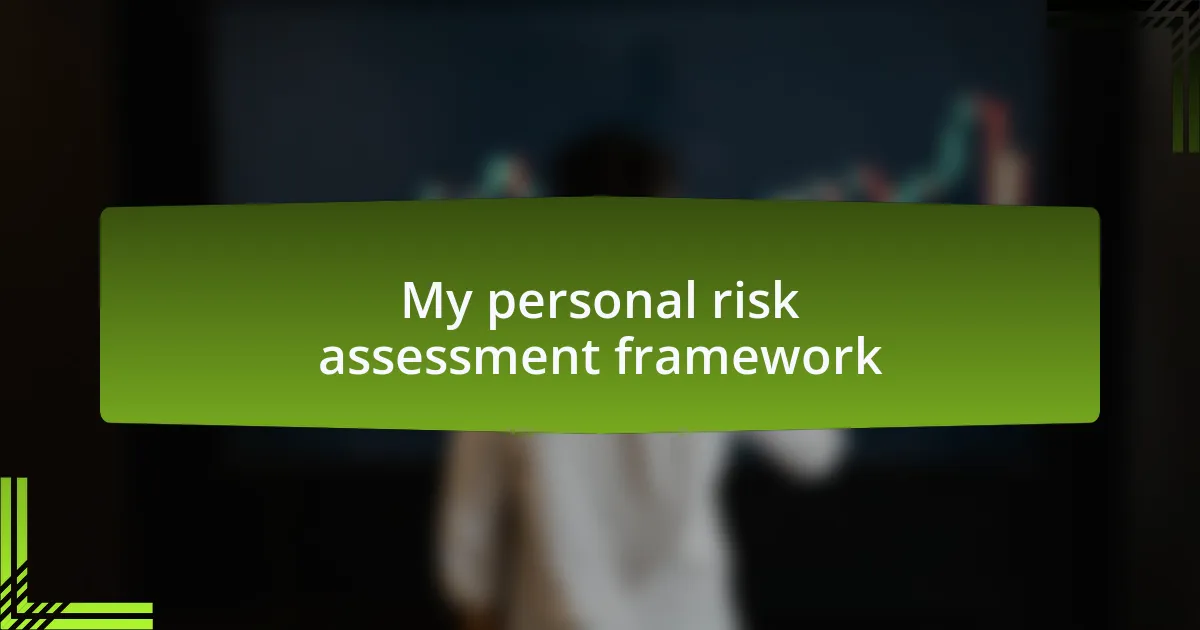
My personal risk assessment framework
When assessing risk, I start by establishing my risk tolerance level, which is a personal benchmark for how much volatility I can endure. I remember the first time I experienced a significant drop in the market; it felt like a punch to the gut. Since then, I’ve realized that understanding my emotional responses to market fluctuations helps me make more rational decisions in the long run. Have you ever evaluated how much risk you can really handle?
Next, I incorporate a detailed analysis of both technical and fundamental factors when considering new investments. I once overlooked a project simply because its whitepaper was dense with jargon, but later learned that the team behind it had a strong track record. This taught me the essential lesson that due diligence goes beyond numbers; it includes understanding the motivations and background of the people involved. What factors do you consider in your own assessments?
Lastly, I consistently review my risk assessment framework to adapt to evolving market conditions. A while back, I became overly confident after a series of successful trades, which led to some hasty decisions. Reflecting on that experience, I now keep a journal to document my thoughts and adjustments, helping me stay grounded and focused. How do you ensure your strategy remains relevant?
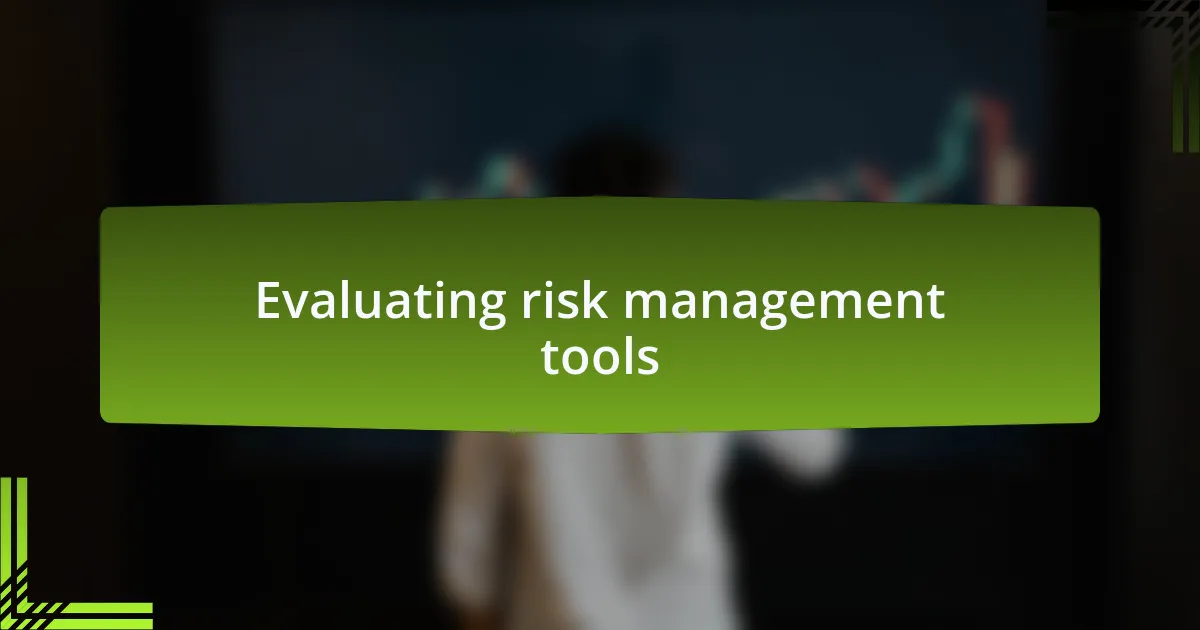
Evaluating risk management tools
When it comes to evaluating risk management tools, I find the process can be quite enlightening. For instance, I once experimented with a portfolio management tool that promised real-time risk assessment. The first time I received a warning about over-exposure to a volatile asset, it felt like a wake-up call. Have you ever had technology reveal risks you weren’t fully aware of? That tool prompted me to adjust my holdings, highlighting how effective a good management tool can be in protecting my investments.
Another aspect I consider is the versatility of the tool. I’ve used platforms that offered strict stop-loss orders, which initially seemed like a safety net. However, I realized my trading strategy required more flexibility to adapt to rapid market changes. This experience taught me that a good tool should not only mitigate risk but also complement my unique approach to trading. How do you ensure that your tools align with your trading style?
Lastly, I evaluate the educational resources a tool provides. While navigating a new trading platform, I once encountered an excellent feature that broke down complex risk concepts into digestible segments. It not only improved my understanding but also increased my confidence in using the tool effectively. What resources do you find valuable in enhancing your risk management knowledge? This blend of support can transform your approach to risk for the better.
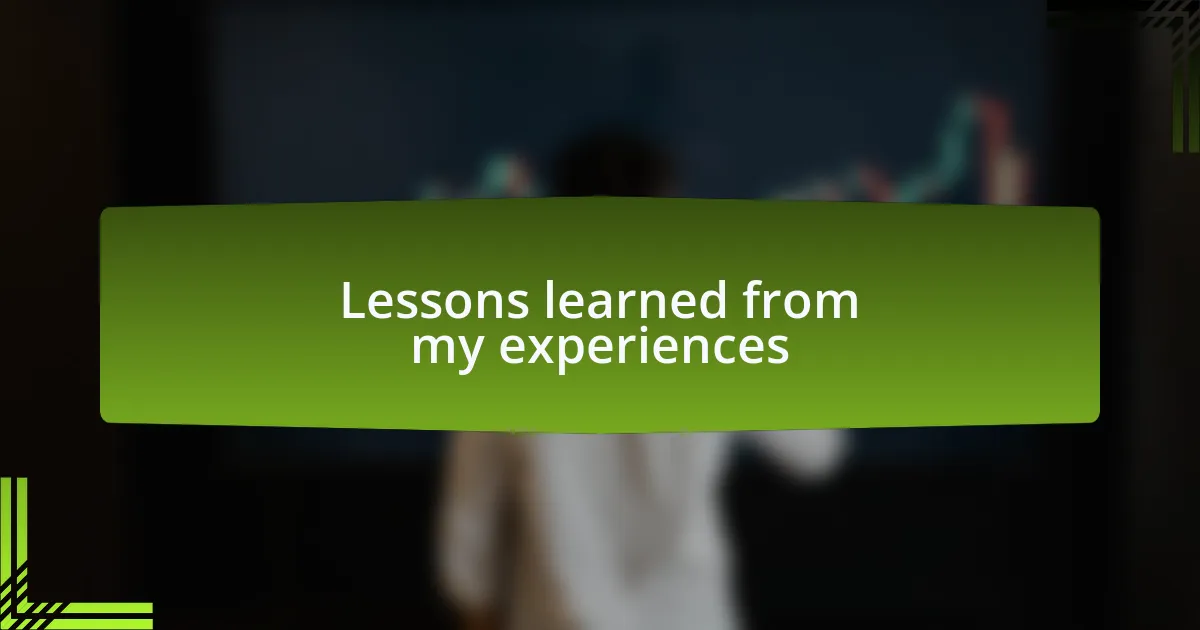
Lessons learned from my experiences
My experiences have taught me that diversification is crucial to risk management. In one instance, I invested heavily in a single promising altcoin, only to watch its value plummet due to unforeseen market volatility. The feeling of panic as I realized my exposure was too concentrated was a hard lesson learned. Have you been in a similar situation? Shifting my focus to a more diversified portfolio not only eased my anxiety but also balanced my overall risk profile.
I also learned the importance of setting clear boundaries for my investments. Early on, I would often second-guess my decisions, letting emotions drive my trading. One night, after a heated discussion in an online forum, I impulsively altered my strategy, which resulted in losses. It struck me that having predetermined entry and exit points is essential to avoid emotional mishaps. How do you combat emotional biases in your trading decisions? Establishing those boundaries has since empowered me to stick to my plan.
Lastly, I discovered that learning from failures is just as vital as celebrating successes. Early in my journey, a poorly timed sell-off taught me the importance of patience. Instead of wallowing in disappointment, I analyzed the situation and adjusted my strategy. I’ve found that each setback offers invaluable insights that can shape a more resilient approach to risk management. Have you ever turned a failure into a learning opportunity? Embracing these lessons has made my path in cryptocurrency much more rewarding.